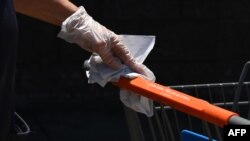President Donald Trump has announced the U.S. government will provide an additional $5 billion in aid, equipment and training to the nation’s nursing homes, many of which are hot spots in the coronavirus pandemic.
He said COVID-19, the disease caused by the coronavirus, poses "the greatest threat to our senior citizens," and that "nearly half of the deaths have occurred among those living in nursing homes or long-term care facilities."
According to federal estimates, nursing home residents accounted for roughly 37,000 COVID-19-related deaths; overall, the U.S. has recorded nearly 143,000 deaths, according to Johns Hopkins University statistics.
“I want to send a message of support and hope to every senior citizen who has been dealing with the struggle of isolation in what should be the golden years of your life," Trump said Wednesday at the White House during the coronavirus news briefing.
“We will get to the other end of that tunnel very quickly, we hope. The light is starting to shine. We will get there very quickly.”
Nursing homes received nearly $5 billion in pandemic relief funds approved by Congress earlier this year. The new package of $5 billion in aid would go toward increased testing of nursing home staff, distribution of a list of those facilities with increased numbers of COVID-19 cases, and additional training and support. Nursing homes in hot spots would get priority.
Biden economic plan
Trump’s announcement comes a day after former Vice President Joe Biden, the presumptive Democratic presidential candidate, released the third plank of his overall economic plan, which focused on child care and home health care, with a pledge to provide 12 weeks of paid family and medical leave.
Also Wednesday, while discussing reopening schools in the fall, Trump was asked by reporters if he was comfortable sending his own son and grandchildren to in-person schools.
"Well, I am comfortable with that,” Trump said. “I would like to see the schools open 100 percent. And we’ll do it safely. We’ll do it carefully.” He said, ultimately, the decision would be up to state governors.
Late Wednesday, Senate Republicans and the White House said they had reached a tentative agreement on the next coronavirus relief package, which would provide about $1 trillion in aid. Legislation is expected Thursday.
Earlier in the day, the U.S. government announced it will pay $1.95 billion to American drug maker Pfizer and German biotech company BioNTech SE for 100 million doses of a COVID-19 vaccine, if it proves to be safe and effective.
The companies said Wednesday they had finalized a deal with the U.S. Department of Health and Human Services and the Defense Department to supply the agencies with a vaccine they are developing jointly, the latest in a number of comparable agreements with other vaccine companies.
Health and Human Services Secretary Alex Azar told Fox News Wednesday the U.S. could buy 500 million additional doses of the vaccine provided they are “safe and effective.”
Operation Warp Speed
The deal announced Wednesday is part of Trump’s Operation Warp Speed initiative, which is aimed at delivering 300 million doses of an approved vaccine by January.
Pfizer and BioNTech said they hope to be ready to pursue some form of regulatory approval as early as October if current studies of the vaccine are successful, and that they currently expect to deliver up to 100 million doses by the end of the year.
The deal was announced one day after more than 1,000 people in the U.S. died of COVID-19, the first time since early June the U.S. reached the single-day milestone, and Trump acknowledged the coronavirus crisis in the country “will ... get worse before it gets better."
The U.S. continues to lead the world in COVID-19 fatalities with more than 142,300, far greater than the 81,487 deaths in second-ranked Brazil, according to Johns Hopkins University statistics. The U.S. also remains the world leader in infections, with 3.5 million of the world’s 15 million coronavirus cases.
Data released Tuesday by the U.S. Centers for Disease Control and Prevention said, however, the actual number of coronavirus infections in some parts of the U.S. is anywhere between two and 13 times what has been officially reported.
The CDC based its conclusions on blood samples collected from people who were given routine clinical tests across 10 geographic regions, including New York City, south Florida, Missouri and the western states of Utah and Washington. In Missouri, for example, the estimated number of actual infections was 13 times the number of confirmed cases, while in Utah, the actual number was at least twice as high.
The authors of the study, which was also published on the website of JAMA Internal Medicine, said many infected people did not seek medical care or get tested because they likely had mild symptoms or none at all, and likely spread the virus among the population. At least 40 percent of people who are infected do not develop symptoms.
The CDC researchers also found that only a small number of people in many parts of the United States were carrying the coronavirus antibodies as of late May, indicating that most of the population remains at risk of infection.
U.S. labs are also struggling to keep up with the increased testing, with some labs taking weeks to return COVID-19 results, experts say.
“There’s been this obsession with, ‘How many tests are we doing per day?'” Dr. Tom Frieden, former CDC director, said in an AP report. “The question is how many tests are being done with results coming back within a day, where the individual tested is promptly isolated and their contacts are promptly warned.”









